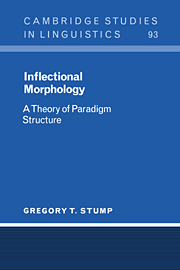7 - Syncretism
Published online by Cambridge University Press: 14 October 2009
Summary
In instances of syncretism, two or more cells within a lexeme's paradigm are occupied by the same form. Syncretism is an extremely common phenomenon in languages with inflectional morphology, one which raises a number of fundamental issues for morphological theory; in this chapter, I examine a number of these issues. I argue (section 7.1) that syncretisms are of at least four types (unidirectional, bidirectional, unstipulated, and symmetrical), and that the assumptions of PFM afford a natural means of capturing their distinctive characteristics: directional syncretisms are an effect of rules of referral (section 7.2), while symmetrical syncretisms are the effect of metarules pertaining to rules of exponence (section 7.3). Rules of referral serving to capture directional syncretisms may interact with other members of the same rule block in two ways (section 7.4): on the one hand, they participate in override relationships mediated by Pānini's principle; on the other hand, they participate in ‘feeding’ relationships. Although syncretism is customarily seen as a property of individual paradigms, there are clear instances of stipulated identity among members of distinct paradigms; in section 7.5, I argue that all such translexemic syncretisms are directional, hence an effect of rules of referral. I conclude (section 7.6) with a discussion of some apparent limits on the expressive potential of rules of referral and syncretism metarules.
Four types of syncretism
In the discussion of Bulgarian verb morphology in chapter 2, a clear instance of syncretism was encountered: in the preterite tenses (i.e. the imperfect and the aorist), a Bulgarian verb's 2sg forms are identical to its 3sg forms; see again table 2.3 (section 2.2).
Information
- Type
- Chapter
- Information
- Inflectional MorphologyA Theory of Paradigm Structure, pp. 212 - 241Publisher: Cambridge University PressPrint publication year: 2001
